Many cat owners wonder a lot about cat wheels, and it is quite funny to imagine your cat felines walking or running on a wheel like a hamster would on a hamster wheel.
It can actually sound a bit ridiculous, but when you think about the number one risk that indoor cats face – obesity. It becomes a lot more plausible to have around the home. Since many owners struggle with keeping active cats stimulated throughout the day or have faced the wrath of a Bengal cat with the zoomies – there is nothing like the cat wheel to solve these problems.
Cat Wheel Pros/Cons
For a quick glance at the pros/cons of a cat exercise wheel, see this chart:
| Cat Wheel Pros | Cat Wheel Cons |
|---|---|
| Allows cats to run & sprint in any type of home. | Some cats might require training to use a cat wheel. |
| Great at passively letting your cats use up energy. | Most cat exercise wheels are quite large. |
| Once trained, cats use it throughout the day. | More expensive than regular cat items (USD 200+). |
| It can be used in single or multi-cat homes. | It can be loud if cats are running or sprinting (70+ dB). |
| Great for young and adult cats. | Cat wheels are circular, so it can be difficult to organize neatly. |
| Easy to assemble & low maintenance. | Cats at full speed sometimes cause the room to shake. |
Are Cat Wheels Good? Are They Worth The Investment?
So are cat wheels worth it? Cat wheels are definitely worth it for indoor-only moderate to high energy cats and kittens to provide them a way to stretch their legs muscles and allow them to run and sprint in the safety of your home! Cats who are highly food motivated and easily trained are also great candidates for using a cat wheel! For cats that have a lot of outdoor access they might not need a cat wheel.
While they are quite a bit of an investment (more than most cat furniture), it quickly becomes something of value because it provides endless hours of entertainment and exercise. It’s a very passive item (I rank activity methods in this article) after the initial adapting/training period and highly effective in doing what it is meant to do.
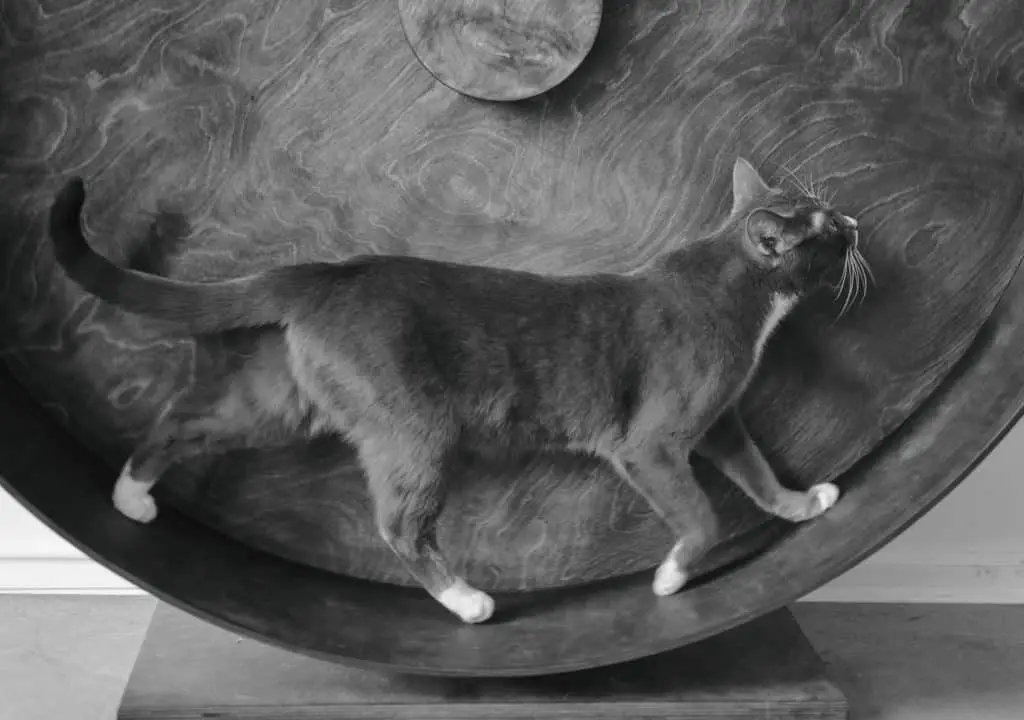
Especially for breeds such as the Bengal, Abyssinian, or the like, a cat wheel can keep them from being uncontrollable in their energy levels. However, even for cats that are known to be more relaxed (such as the Russian Blue or Scottish Fold), as long as they are motivated by food, they can be easily trained. Therefore, a cat wheel can be a great tool to introduce into their routine to facilitate an active life and keep obesity at bay.
In my apartment, second to my Bengal cat, my Scottish Straight loves to use the wheel. She goes on it for almost 10 minutes at a time, just walking away. It becomes an invaluable tool for cats trained for it for both the cats and their owners.
Do Cats Actually Use Cat Wheels?
Cats that have moderate to high energy levels will take the fastest to use a cat exercise wheel. Most popular cat wheels (such as the OneFastCat cat wheel) are typically designed for cats up to 11 kg or 25 lbs. Therefore, a cat exercise wheel is more likely going to be used by cats that are under the weight requirements and in relatively decent shape. Obese cats that are over the weight requirements (above 11kg) may require more effort to train them to use the cat exercise wheel.
Are Cat Wheels Good for Apartments or Studio Apartments?
One of the downsides of a cat wheel is that they are a little bit large. So it might take up a bit more room than other cat furniture would. The value that it brings, however, to an apartment outweighs this negative.
A cat wheel offers our cats exercise and stimulation, but at the same time, it also offers us cat butlers time itself. Cats trained on the cat wheel use it up to 3 hours throughout the day – on and off. This means that we might have an extra 3 hours a day of our cats not bothering us (if your cats are the super clingy type)!
Also, from a stylistic point of view, it is much lighter visually compared to totally solid (like a cat tower) because you can see through the wheel. So while it might be large, it doesn’t make your home look cluttered or claustrophobic.
Why Use Cat Wheels?
Cat wheels provide indoor cats with a lot of benefits:
- For indoor cats to get exercise through sprinting, running, or walking.
- Very rarely does any cat have this opportunity in a large house, let alone in a studio apartment. Therefore, having a cat wheel brings a lot of value and engagement to all indoor cats of all ages.
- Allow indoor cats to release their pent up energy throughout the day, thus, reducing behavioral issues and destructive actions!
Outdoors, cats can cover massive distances in a sprint (almost up to 30 mph!) As such, the use of cat wheels in an apartment or home can have many benefits – they allow the cat to use their full stride and use more parts of their muscles (thus, spending more calories & tiring them out). Cat wheels are great for cats mentally too as it provides another layer of enrichment indoors.
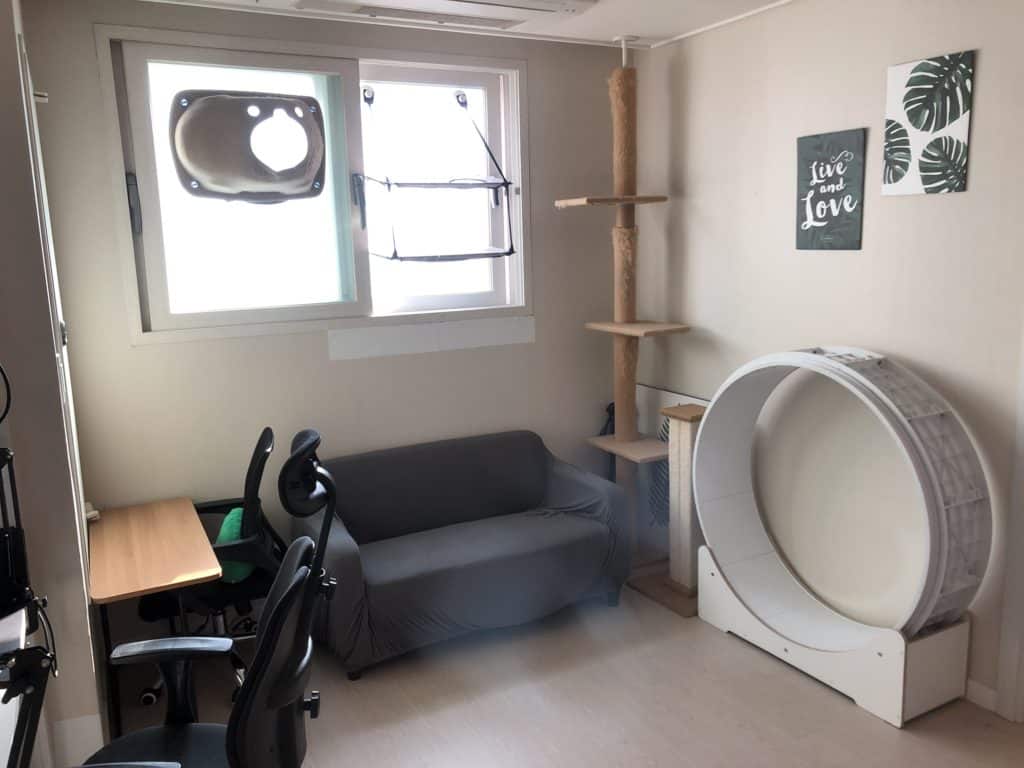
Another great benefit of a cat wheel is that since it’s quite a passive item to have around, it’s handy for people that are either working a lot or sometimes go on trips for (1-2 days) so that the cats are still able to entertain and exercise even when you’re not around.
Cat wheels are generally large enough to accommodate more than one cat so that 2 cats can walk on them simultaneously. However, that’s pretty rare, and usually, one cat will take over the cat wheel, and they’ll take turns going on and off the cat wheel.
How Expensive Is A Cat Wheel?
Each company approaches making cat wheels in different ways. Thus, cat exercise wheels can vary widely in price. Here’s what to expect in terms of prices and the cost of specific cat wheels:
- Most standard plastic cat wheels are about $199-$250 USD.
- More premium cat wheels made of more higher quality (but heavier) materials can cost up to $1000 USD
- One of the most popular cat wheels out there, OneFastCat Cat Wheel, is exactly $249 USD.
- The best premium cat wheel out there is the Hoiru Cat Wheel and it costs exactly $999 USD.
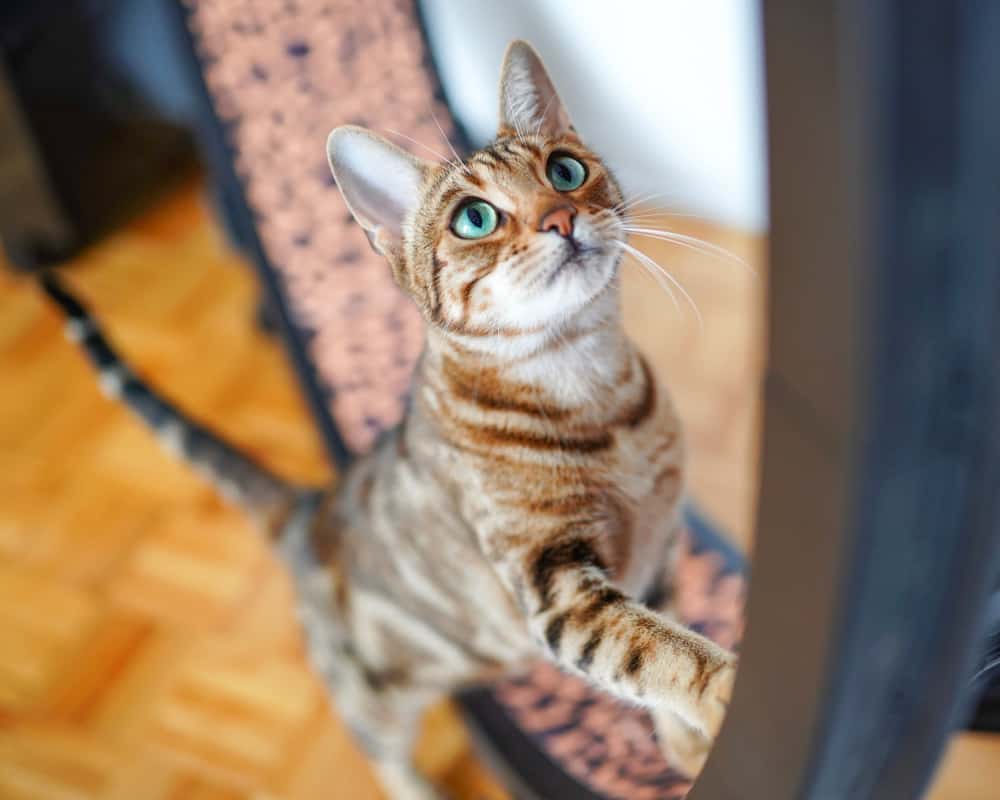
Depending on where you live, you might come across more premium cat wheels made of wood or use a different type of spinning/movement system. They cost substantially more, but they’re generally better made, more aesthetically pleasing, and smoother to operate.

Some wheels might even have locks on them to stop the wheel from spinning at night time. However, I’ll show you an easy life hack to do that with any wheel down below in the tips section.

What Size Should Cat Wheels Be?
In general, the larger the cat wheel, the better. It lets your cat stretch out its spine in a full sprint rather than being all scrunched up on a small one. Also, a cat exercise wheel should be big and sturdy enough for any sized cat to run on it without it sliding around on the floor.
Using the OneFastCat as the standard cat wheel – these are the typical dimensions of a cat wheel:
Assembled 48″ L x 47″ W x 10.75″ H & Weight is 25 lbs.
Therefore, that a good cat wheel should be 48 inches in diameter minimum and around 25+ lbs.
What Are Some Cat Wheel Negatives?
Cat wheels have two main negatives:
- Cat wheels are quite large and take up quite a bit of space.
- Can be loud if cats are sprinting.
A cat exercise wheel is about the size of a 42-50 inch TV on a stand. Many people know that I use a cat wheel inside my studio apartment. Although it is large, its benefits to a small space for cats are worth it. However, those living in a smaller apartment than 30 square meters or smaller might find it difficult to fit a cat wheel in their home.
Depending on how fast cats run on the wheel, cat wheels can be loud. So cat wheels might not be recommended if you are sensitive to rumbling or similar types of sounds. However, if you’re worried about it making sounds while you’re asleep – scroll down to the tips section for the solution!
| Cat Wheel Usage | Noise Level |
|---|---|
| Cat Walking on Cat Wheel | 50-60 dB (low rumble, louder than the average home noise) |
| Cat Running/Sprinting on Cat Wheel | 70-75 dB (loud rumble, similar to the noise inside a car at 60 mph) |


On a wheel, a cat will either walk or run. So let’s approximate some of these situations.
A cat wheel spinning slowly will be about 50-60 dB, that’s about a little bit more than the average home noise.
A cat sprinting or running will be quite a bit more than that. I would approximate it to about 70-75 dB. Rather than a wooing of a vacuum cleaning, it’s more a hollow rumble sound created by the main cat wheel spinning and making contact with the skateboard wheels underneath.
Luckily, however, cats are not dogs, and they don’t sprint for long periods of time. The maximum length of time that they might sprint in one session is about 30 seconds. For me, it’s a non-issue. However, for other people, it might be a problem.
Maintenance of Cat Wheels
So you’ve bought your first wheel and were wondering about the maintenance and upkeep of cat wheels? Luckily there’s not much to manage. Once it’s set up, it doesn’t have that many parts to deal with.
Clean your cat wheel about once a month with a damp cloth and wipe it down to preserve the color of the wheel. Cat paw prints and dirt are bound to be on it, and we don’t want to have the wheels underneath the cat wheels be grimy as it might affect the spin of the skateboard wheels.

As such, it’s also a good idea to take off the main wheel and to clean and maybe even grease up the wheels underneath so that it gets a good spin.
Which Cat Breeds Use Cat Wheels The Most?
Most cats can be trained to use the cat wheels. However, there are just some cats that are more bold and inclined to use the wheel.
The cats most likely to use the cat wheel goes as follows:
- Bengal cats
- Savannah cats
- Abyssinian cats
- Siamese cats
- Maine Coon cats
The above breeds are just so curious and bold that they quickly take to it without much training. They are typically the most energetic breeds, so they use it more frequently and longer than other cats. Latte, my Bengal cat, goes on the wheel every day religiously.
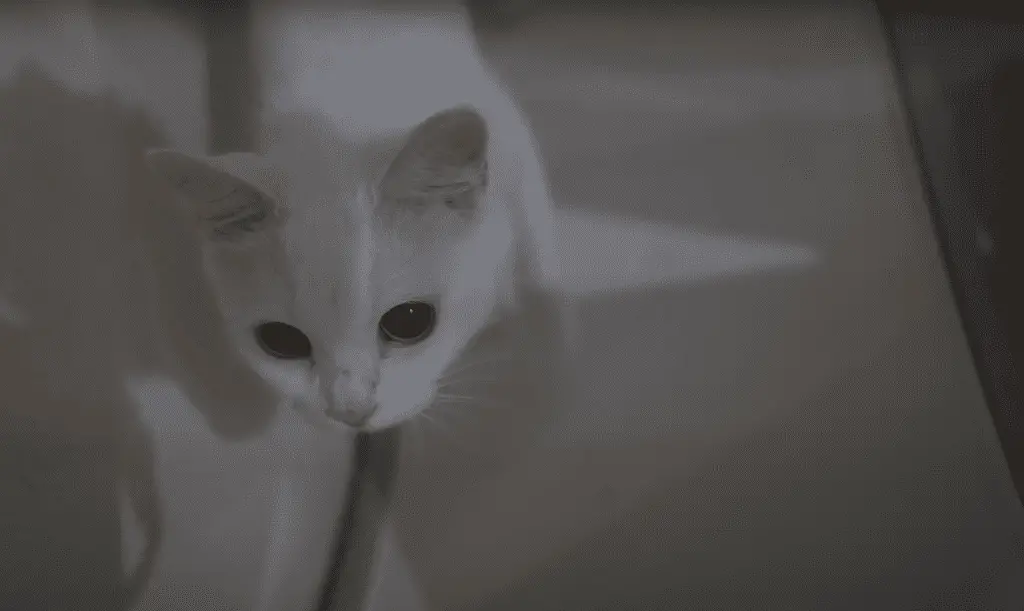
If your cat doesn’t belong to any of the above breeds, it doesn’t mean that they won’t go on the wheel. They might take some extra time to get used to it, but with training and with a bit of reinforcement with treats – they can easily go on the wheel.
How Do You Train Your Cat To Go On a Cat Wheel?
Training your cat to go on the cat wheel is actually quite easy. The 2-3 items that you might need are:
- Laser pointer
- Feather wand stick
- Small dry snacks
Laser Pointer Training Method
This is probably the easiest method as all you would need to do is point the laser point towards a point on the wheel that the cat would want to try to get to. As the cat tries to go for the dot on the wheel, the wheel automatically moves, so he starts a walk.
Very bold cats will actually try to chase it down and go on a full-on sprint. Remember, if your cats do any sort of walking on the wheel, give them a snack or a treat every time he goes past his comfort zone. Your cats should eventually go on the wheel by themselves through constant repetition and a consistent training schedule.
Feather Wand Training Method
This method is quite similar to the above – instead of the laser pointer, we use the wand stick.
Wave the wand back and forth on a point on the wheel that is a bit further than your cat to have them try to chase it.
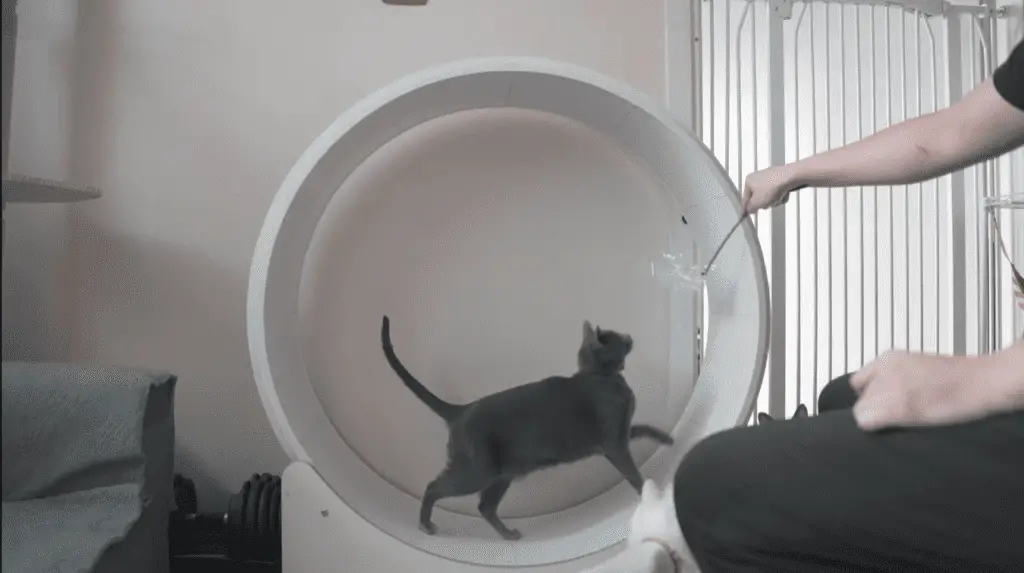
This method could work a bit better as the cats have something solid that they can touch. So after they walk towards it or run, let them catch the feather wand for a second to satisfy their hunting drive and give them a snack.
Again, repeat this method for about 10-20 minutes a day until they start going on the wheel by themselves.
Dry Snack Training Method
This method is useful for very food motivated or sensitive cats who are wary of their cat wheel. Instead of going on a full-on run, it allows them to get acclimated to the wheel by walking slowly.
Put the treat in front of their nose to get their attention and hold it further away from your cat. As they walk towards your treat, count approximately in your head about how long they walk for. Then give them the treat. For each subsequent day you do this method, try to get them to walk longer and longer before giving them their treat.
For example,
Day 1: Make it easy for them to get a treat. If they get on the cat wheel, give them a treat. If they attempt to walk on it, give them a treat.
Day 2: Have them walk for 2-3 seconds then give them a treat.
Day 3: Have them walk for 5 seconds then give them a treat…etc.
Rinse and repeat and keep pushing their boundaries until they start walking by themselves without your initiation.
Cat Wheel Tips and Hacks
So if you have purchased a cat wheel already and enjoying it, these are some cat wheel hacks.
- When the tracking of the cat wheel gets old, ripped, and worn out, just remove it. Cats can still run without the grip track.
- Put the cat wheel towards a wall/corner for stability so that it doesn’t slide around while the cats use it.
- Before bedtime, take the wheel off the skate tracks and lean it towards the wall so the cats can’t run on it (and wake you up).
- Put some rubber feet on the base of the wheel to absorb some of the shocks that might be caused when the cats run on it. This substantially lessens the noise that might be produced.
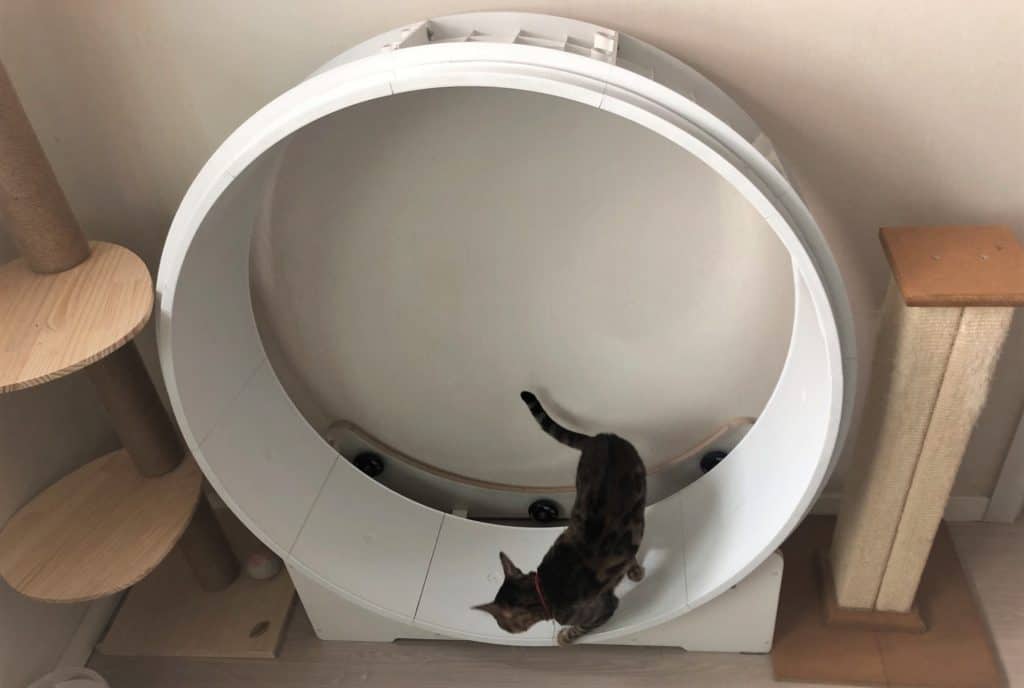
Conclusion: My Recommendation
For most cat owners, the OneFastCat Cat Wheel is the best value/price proposition.
It’s easiest to assemble, clean, and replaced (if need be). And while it could be improved in terms of its operation, quietness, and functionality (maybe including a lock would be nice).
For those cat owners chasing a certain type of aesthetic or have particularly sensitive neighbors (due to noise), the more expensive wheels generally run smoother and quieter. Also, they’re generally just much better built. Below is the cat premium cat wheel that I recommend.
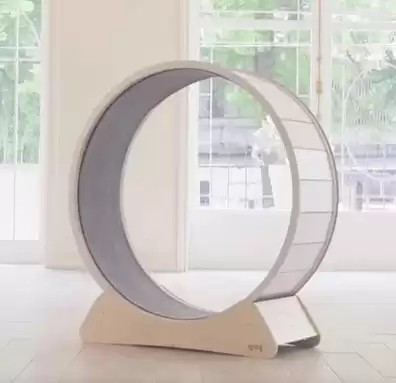 Hoiru Premium Cat Wheel
Hoiru Premium Cat Wheel
With a solid oak base and a modern round shape, this cat wheel entices cats to exercise. The thin, light grey felt encourages cats to scratch, climb and grip as the wheel turns. Neutral colors compliment the color scheme of any home and the moving wheel provides a unique exercise element to a cat's home.
In conclusion, cat wheels are quite a hefty investment initially, but they quickly become a valuable tool within your home or apartment.
Using different methods, it’s straightforward to train a cat to go on the wheel. When they are accustomed to going on the wheel, they will automatically run on it to relieve themselves of their pent-up energies.
It is beneficial physically and mentally for your cats, and you also get some extra time throughout the day as they are preoccupied with running or walking on the cat wheel.
Of course, however, it might not be right for everyone. A cat wheel can be a bit too large for some places or noisy for certain people!


Great tips! How often does Ash use the wheel? Do you think the investment is worth it if I’m planning on having only one Russian blue?
In my opinion, cat wheels are an even better investment if you are planning on having just one cat (since it’s just a nice way for them to use up their excess energy throughout the day). If you train them on it when they’re young, they’ll likely keep using it even when they’re older. My Russian Blue loves going on it (when the other cats aren’t using it).
My senior cat is still in good shape as far as I know. She can still jump up on dressers, counters, and on her tallest perch. Im concerned because we moved 3 months ago and we live in a real tight spot with no yard. She loved the place we use to rent in the country because she went outside sometimes to smell the fresh air and walk around and see all the birds and taste the fresh grass, she loved it. Now that we moved and don’t have the big yard I feel she is depressed. She doesnt act the same; to me I feel shes missing the other place where we lived for over 6 years. In fact, she wont go outside, she doesn’t want to.now. She doesn’t get much exercise and eats, then goes to sleep. That’s is all she does all day each day..
If I invest in this Cat Wheel and she doesn’t use it or doesn’t have any interest in it, can I get my money back?? This is an expensive item so I’m just asking this question before I purchase it
Hope to heR from you soon, thankyou.
My CAT wheel is ridden everyday. I have several pointers on the couch….at the ready! My Savannah is a speed demon and never gets tired…almost never. Of my 3 Savannahs, on two have an interest. My youngest prefers to walk. He also prefers to walk in the opposite direction of my speedy boy Keikei. We ordered a larger wheel before Xmas this year and will pass down this one to our Sons 2 Savannahs. I’d be happy to email video if anyone is considering buying a wheel. Hint. I can hold the pointer on the wheel as I watch football.
Any advice for a 10 mo. old Bengal who scared himself by going too fast on it, and now he’s quite hesitant. He will go over to it and get on it and walk, but only briefly. He desperately needs exercise because he’s bored and started biting me recently, in spite of my throwing toys for him throughout the day and getting him shelves to climb on. 🙁 I have plenty of cat experience, growing up with Siamese and then having Tonkinese for 50+ yrs, but his activity level puts them all to shame! He goes crazy and then too fast with the laser, and catches the feather, no matter how hard I try to keep it out of his reach. I will give the dry treats a try….